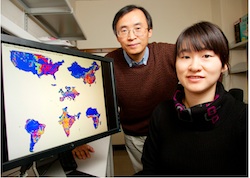According to a new paper published in the journal Environmental Science and Technology, “Land Availability for Biofuel Production,” authored by researchers from the University of Illinois, using detailed land analysis, biofuel crops cultivated on available land could produce up to half of the world’s current fuel consumption. This could be done, the researchers say, without negatively affecting food crops or pastureland.
The study was led by civil and environmental engineering professor Ximing Cai who identified land around the globe available to produce grass crops for biofuels, with minimal impact on agriculture or the environment. Cai noted going into the study that prior research concentrated on biofuel crop viability focused on biomass yield or how productive a crop could be regionally; yet, there was little research on land availability, a key constraint of biofuel development. He also noted that there is major concern as to whether, on a global scale, biofuels can meet fuel demand without compromising food production.
 “The questions we’re trying to address are, what kind of land could be used for biofuel crops? “If we have land, where is it, and what is the current land cover?” said Cai.
“The questions we’re trying to address are, what kind of land could be used for biofuel crops? “If we have land, where is it, and what is the current land cover?” said Cai.
For this particular study, Cai’s team assessed land availability from a physical perspective – focusing on soil properties, soil quality, land slope, and regional climate. The researchers collected data on soil, topography, climate and current land use from some of the best data sources available, including remote sensing maps but the point of differentiation of this research was that the study only considered marking land for biofuel crops. By doing this, current crop land, pasture land and forests were ruled out as viable land options for biofuel production. In addition, the research team ruled out any land that must be irrigated, thus eliminating concerns over the need to divert water from agriculture crops.
 Using fuzzy logic modeling, a technique to address uncertainty and ambiguity in analysis, the researchers considered multiple scenarios for land availability. First, they considered only idle land and vegetation land with marginal productivity; for the second scenario, they added degraded or low-quality cropland. For the second scenario, they estimated 702 million hectares of land available for second-generation biofuel crops, such as switchgrass or miscanthus.
Using fuzzy logic modeling, a technique to address uncertainty and ambiguity in analysis, the researchers considered multiple scenarios for land availability. First, they considered only idle land and vegetation land with marginal productivity; for the second scenario, they added degraded or low-quality cropland. For the second scenario, they estimated 702 million hectares of land available for second-generation biofuel crops, such as switchgrass or miscanthus.
The researchers then expanded their sights to marginal grassland including low-impact high-diversity (LIHD) perennial grasses. By adding this category, the amount of land nearly doubled to 1,107 million hectares globally.
“Based on the historical data, we now have an estimation for current land use, but climate may change in the near future as a result of the increase in greenhouse gas emissions, which will have effect on the land availability,” said graduate student Xiao Zhang, a co-author of the paper.
“We hope this will provide a physical basis for future research,” said Cai “For example, agricultural economists could use the dataset to do some research with the impact of institutions, community acceptance and so on, or some impact on the market. “We want to provide a start so others can use our research data.”
Next, the team plans to study the possible effect of climate change on land use and availability. Former postdoctoral fellow Dingbao Wang, now at the University of Central Florida, also co-wrote the paper.

